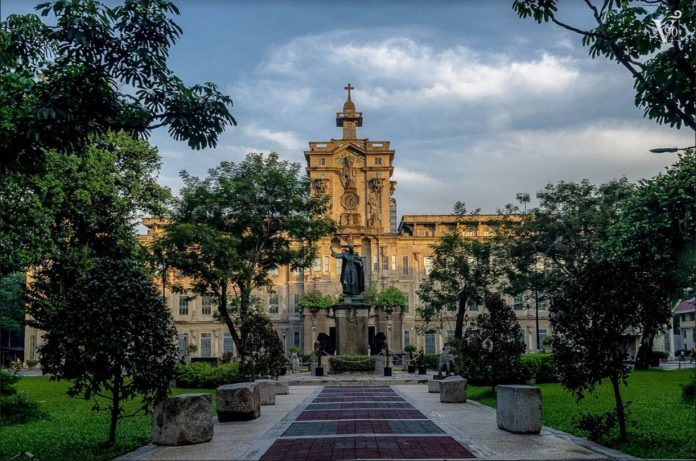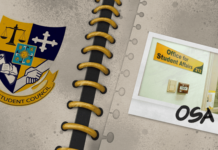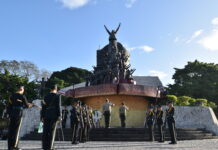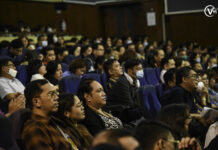UNLESS the academic load of faculty members is reduced and the criteria for faculty research are revised, the University will not rise in the Quacquarelli-Symonds (QS) World University Rankings, researchers said.
The University must reduce the academic units of faculty members so they can devote more time for research, said Joyce Arriola, director of UST’s Research Center for Culture, Arts and Humanities.
“If you’re the faculty and so much is expected of you, such as to publish one article a year in a Scopus, you will opt to teach nalang because that’s your comfort zone…. bago ka makasulat ng article ang classes mo ay seven… may klase ka pa din na marami,” Arriola told the Varsitarian.
Faculty members have to render 21 teaching units and are urged to publish scholarly works locally or internationally, Arriola said. She suggested that the full academic load be reduced to 12.
Arriola, who has doctorates in communication and literature,also expressed dismay on the number of students per class, blaming it on the University’s “business model” that accepts too many enrollees.
“If a university will not protect its faculty, take care of it, if the faculty is [burdened] at the end of the day, overworked with 44 students in a class, checking [papers] and then you expect them to return the papers after a week, that’s too much,” she said.
This is not the first time a faculty member raised such concerns, as the first consolidated Collective Bargaining Agreement draft, which was distributed to UST Faculty Union (USTFU) members for review in September 2018, proposed a reduction of the faculty members’ academic loads, among others.
The panel also proposed to cut the number of students forlaboratory and lecture classes to conform with the standards of the Association of Southeast Asian Nations University Quality Network, which recommends no more than 30 students per class.
UST is ranked within the 801-1000 bracket of the QS worldwide university rankings, a position it has held since 2018. It clung to the 701+ bracket for four consecutive years before landing onthe current spot.
UP remained the only school in the Philippines ranked in the top 500 universities in the world, while UST is still the only university in the country with a QS four-star rating.
According to the QS Top Universities website, a university with a four-star rating is “highly international, demonstrating excellence in both research and teaching, and provides an excellent environment for students and faculty.”
UST retained its perfect five-star ranking in employability, facilities, social responsibility and inclusiveness.
The QS world ranking is based on six factors: academic reputation (40 percent), employer reputation (10 percent), faculty–student ratio (20 percent), citations per faculty (20 percent), international faculty ratio (five percent) and international student ratio (five percent).
Research criteria slammed
Arriola said the criteria of excellence for faculty researchers in the University should be revised. She lamented how the framework leans in favor of the sciences, when there are also “quality publications” that should be taken into consideration inthe pointing system.
The criteria, obtained by the Varsitarian, showed that researches refereed internationally in the Institute of Scientific Information (ISI) or researches that are in Scopus, a bibliographic databaseof academic journal articles worldwide, would award 40 points to a faculty member, compared with non-ISI or non-Scopus indexed researches that score 20 points.
A scholarly work published nationally is equivalent to 15 points while a work published locally gets five points.
The pointing system for full-length books released through a “reputable publisher,” the framework added, goes as follows: sole authorship would give a faculty member 50 points; co-authorship, 40 points; and editor and revision contributions, 10 and five points, respectively.
The research framework, she said, should also factor in the researcher’s performance. Once the criteria are revised, incentives would follow.
“If performance-based [criteria] may be reflected in our research excellence framework, [aside from the print-based] then we can claim [research excellence] eventually,” Arriola said. “If you go around the world, all of these research-related activities are also factored in the output of the faculty so we have to do something with the criteria,” she added.
Paolo Bolaños, chairman of UST’s Department of Philosophy, echoed Arriola’s concerns, saying there should be a “more inclusive criteria for research incentives.”
Bolaños said the University has no incentive program for researchers. He added the criteria of excellence was“questionable.”
“We have to come up with a more nuanced, more rational and more inclusive criteria for research incentives,” Bolaños said. “If they want to encourage more faculty to publish… We have to benchmark a bit, try to find out what [other universities] are doing,” he added.
The existing research scheme has also become a “policing mechanism that does not encourage the faculty to do more research,” he said.
“A lot of faculty members don’t have the motivation… They are discouraged. Minsan they are discouraged kasi the way that they were brought–the way they were oriented, parang sa kanila it’s a burden,” he said.
Department chairmen, he said, should assist in “building the right mindset” for faculty members to do research, complemented by the necessary physical infrastructure.
The Varsitarian reached out to Nestor Ong, UST deputy director for QS rankings, but he has yet to respond.
Prof. Maribel Nonato, vice rector for research and innovation, meanwhile, declined to comment.
‘Perception game’
Bolaños described the QS Rankings as a “perception game” where rules are imposed by an outside entity, not academic institutions.
While the game must be played by universities, he said UST should not be too preoccupied with the rankings.
“The prestige that comes with being ranked by QS is a perceptual thing… [But] it should be a guide. As a guide, we have to pay attention to it… they come up with a criteria and they impose it on universities with different characteristics, different strengths so you’d get different results,” he said.
Arriola also urged the University to invest in its faculty members, as the QS Rankings also hinge on academic reputation and the strength of its teaching personnel.
“It is really important for us to be known for excellence. A university should be known for its faculty, not for whether it is ISO–certified or it got the most number of accreditations in the different disciplines… QS is peer recognition,” she said.
Other universities, she said, should be able to name faculty members from the University as “stand outs” and experts from the field.
“I received communication from QS naming professors from UP, other universities aside from UST. That’s how it goes. That’s how the game is played. It is really peer recognition. I think it is important that you are recognized in the field,” she said. with reports from Lady Cherbette N. Agot



















